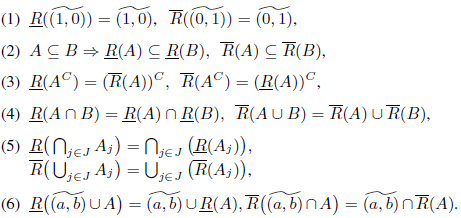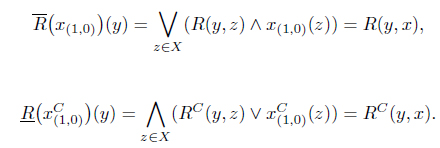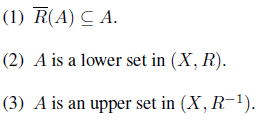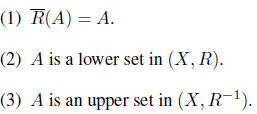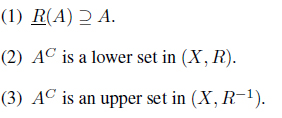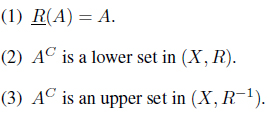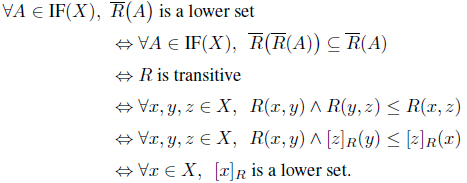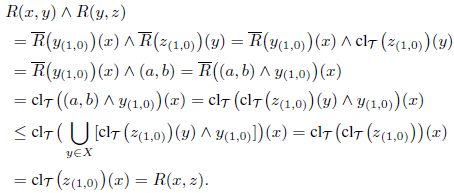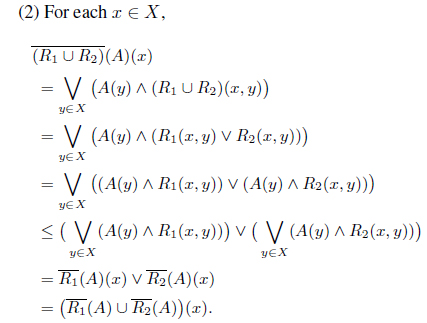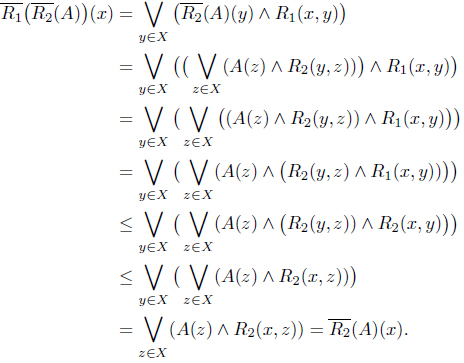



A Chang’s fuzzy topology [1] is a crisp subfamily of fuzzy sets, and hence fuzziness in the notion of openness of a fuzzy set has not been considered, which seems to be a drawback in the process of fuzzification of the concept of topological spaces. In order to give fuzziness of the fuzzy sets, Çoker [2] introduced intuitionistic fuzzy topological spaces using the idea of intuitionistic fuzzy sets which was proposed by Atanassov [3]. Also Çoker and Demirci [4] defined intuitionistic fuzzy topological spaces in Šostak’s sense as a generalization of smooth topological spaces and intuitionistic fuzzy topological spaces. Since then, many researchers [5–9] investigated such intuitionistic fuzzy topological spaces.
On the other hand, the theory of rough sets was proposed by Z. Pawlak [10]. It is a new mathematical tool for the data reasoning, and it is an extension of set theory for the research of intelligent systems characterized by insufficient and incomplete informations. The fundamental structure of rough set theory is an approximation space. Based on rough set theory, upper and lower approximations could be induced. By using these approximations, knowledge hidden in information systems may be exposed and expressed in the form of decision rules(see [10, 11]). The concept of fuzzy rough sets was proposed by replacing crisp binary relations with fuzzy relations by Dubois and Prade [12]. The relations between fuzzy rough sets and fuzzy topological spaces have been studied in some papers [13–15].
The main interest of this paper is to investigate characteristic properties of intuitionistic fuzzy rough approximation operators and intuitionistic fuzzy relations by means of topology. We prove that the upper approximation of a set is the set itself if and only if the set is a lower set whenever the intuitionistic fuzzy relation is reflexive. Also we have the result that if an intuitionistic fuzzy upper approximation operator is a closure operator or an intuitionistic fuzzy lower approximation operator is an interior operator in the intuitionistic fuzzy topology, then the order is an preorder.
Let
where the functions 𝜇
Throughout this paper, ‘IF’ stands for ‘intuitionistic fuzzy.’
For any IF set
is called an
Note 𝜋
IF(
Definition 2.1. ( [2, 17]) Any subfamily of IF(
(1) for each (a, b) ∈ I ⊗ I, , (2) A, B ∈ implies A ᑎ B ∈ , (3) {Aj ∣ j ∈ J} ⊆ implies ∪j∈J Aj ∈ .
The pair (
An IF topology is called an
Definition 2.2. ( [20]) An IF set
(i) reflexive if R(𝑥, 𝑥) = (1, 0) for all 𝑥 ∈ X, (ii) symmetric if R(𝑥, 𝓎) = R(𝓎, 𝑥) for all 𝑥, 𝓎 ∈ X, (iii) transitive if R(𝑥, 𝓎) Λ R(𝓎, z) ≤ R(𝑥, z) for all 𝑥, 𝓎, z ∈ X,
A reflexive and transitive IF relation is called an
Let
Definition 2.3. ( [21]) Let
Similarly, the
The pair is called the
Proposition 2.4. ( [17, 21]) Let (
Remark 2.5. Let (
Let (
Theorem 2.6. ( [17, 21]) Let (
(1)
(2)
3. IF Rough Approximation Operator
Definition 3.1. ( [22]) Let (
Dually,
Let
The classical preorder 𝑥 ≤ 𝓎 can be naturally extended to
Proposition 3.2. Let (
Proof. (1) ⇒ (2). Suppose that . Since for each 𝑥 ∈
we have
Thus
(2) ⇒ (3). This is obvious. (3) ⇒ (1). Suppose that A is an upper set in (X, R–1). Then for any 𝑥, 𝓎 ∈ X, A(𝑥) Λ R–1(𝑥, 𝓎) ≤ A(𝓎). So A(𝑥) Λ R(𝓎, 𝑥) ≤ A(𝓎). Thus
Hence .
Corollary 3.3. Let (
Proof. This holds by Theorem 2.6 and Proposition 3.2.
Proposition 3.4. Let (
Proof. (1) ⇒ (2). Suppose that . Since for each 𝑥 ∈
we have
Thus
(2) ⇒ (3). This is obvious. (3) ⇒ (1). Suppose that AC is an upper set in (X, R–1).
Then for any 𝑥, 𝓎 ∈
So
Hence .
Corollary 3.5. Let (
Proof. This holds by Theorem 2.6 and the above proposition.
For each
Theorem 3.6. Let (
(1)
(2)
(3)
Proof. (1) and (2) are obvious. (3) By Proposition 3.2,
Also,
Proposition 3.7. Let (
Proof. By Remark 2.5, , because
Theorem 3.8. Let
(1) is a closure operator of . (2) is an interior operator of .
Proof. Suppose that satisfies (1). By Remark 2.5, for each 𝑥 ∈
Thus
Hence
Similarly we can prove for the case of (2).
Definition 3.9. For each
Obviously,
Proposition 3.10. Let (
Proof. (1) (⇒) Suppose that . Note that for each 𝑥 ∈
Then
(⇐) Suppose that for each (𝑥, 𝓎) ∈
(i) If
(ii) If
Hence for any
Then
(⇐) Suppose that for any (𝑥, 𝓎) ∈
(i) If
(ii) If
Thus . Hence .
Corollary 3.11. Let (
Proof. By the above proposition and the reflexivity of
Let
Proposition 3.12. Let (
Proof. (1) For each 𝑥 ∈
Thus we have . Dually,
Thus we have . Moreover, since
Proposition 3.13. Let (
Proof. (1) By Theorem 2.6, and . Thus we have
Similarly, we can prove that
(2) The proof is similar to (1).
Proposition 3.14. Let (
Proof. By Theorem 2.6, For each 𝑥 ∈
Thus . So . By Proposition 2.4,
We obtained characteristic properties of intuitionistic fuzzy rough approximation operator and intuitionistic fuzzy relation by means of topology. Particularly, we proved that the upper approximation of a set is the set itself if and only if the set is a lower set whenever the intuitionistic fuzzy relation is reflexive. Also we had the result that if an intuitionistic fuzzy upper approximation operator is a closure operator or an intuitionistic fuzzy lower approximation operator is an interior operator in the intuitionistic fuzzy topology, then the order is an preorder.









